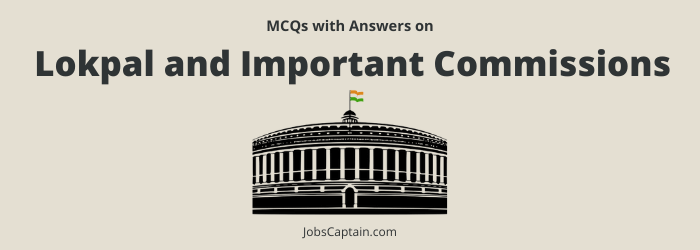
This blog post provides an MCQ on Lokpal and important commissions, with questions to test your knowledge on this important topic.
| Quiz Set | 1 | 2 | MCQ on Indian Polity and Governance |
Question 1: Which of the following Commissions/Committees has recommended the creation of a Local Body Ombudsman?
(A) First Administrative Reforms Commission
(B) Second Administrative Reforms Commission
(C) Balwant Rai Mehta Committee
(D) Ashok Mehta Committee
Question 2: Name the committee which has investigated and submitted the report on the nexus of politicians and criminals?
(A) Gyanprakash Committee
(B) Vohra Committee
(C) Goswami Committee
(D) Rajamannar Committee
Question 3: The first Lokpal Bill was presented in the Parliament in __________.
(A) 1967
(B) 1971
(C) 1968
(D) 1972
Question 4: Who recommended to end Indian Administrative Services and Indian Police Services?
(A) Dhebar Commission
(B) Kelkar Commission
(C) Kher Commission
(D) Rajamannar Commission
Question 5: The establishment of Lokpal and Lokayukta in India was recommended by _________.
(A) Sarkaria Commission
(B) Administrative Reforms Commission
(C) Law Commission
(D) Thakkar Commission
Question 6: Under which Article of the Constitution of Protection of Human Rights Ordinance was issued by the President in 1993?
(A) Article 123
(B) Article 124
(C) Article 125
(D) Article 127
Question 7: Indian Model of Ombudsman is __________.
(A) Lekhpal
(B) Tehsildar
(C) Governor
(D) Lokpal
Question 8: When did the Protection of Human Rights Act come into force in India?
(A) 1990
(B) 1991
(C) 1992
(D) 1993
Question 9: Which of the following has recommended that the appointment of Judges to Higher Courts should be through the participation of the Executive, Legislature, and Chief Justice?
(A) National Commission to Review the Working of the Constitution
(B) National Judicial Commission
(C) Second Administrative Reforms Commission
(D) Report of Law Commission
Question 10: What was the objective of the Protection of Human Rights Act, 1993?
(A) Better protection of Human Rights
(B) To constitute Human Rights Protection Commission
(C) To constitute Human Rights Protection Commission in the State
(D) All of the above
Question 11: In which of the following States, the office of Lokayukta was first established?
(A) Maharashtra
(B) Uttar Pradesh
(C) Bihar
(D) Odisha
Question 12: Who is not a member of the committee for the appointment of the Chairperson and members of the National Human Rights Commission?
(A) Speaker of the House of People
(B) Chairman of the Council of States
(C) Leader of opposition in the House of People
(D) Leader of opposition in the Council of States
Question 13: The Lokayukta of Uttar Pradesh submits its report to ___________.
(A) Chief Minister
(B) Chief Justice of High Court
(C) Governor
(D) Speaker of Legislative Assembly
Question 14: In which Section of the Human Rights Protection Act, 1993 is ‘Public Servant’ defined?
(A) Section 2
(B) Section 3
(C) Section 2(H)
(D) Section 2(M)
Question 15: The first Indian State to pass the Lokayukta Bill in 2011 is ___________.
(A) Uttar Pradesh
(B) Bihar
(C) Uttarakhand
(D) Jharkhand
Question 16: According to the National Human Rights Commission Act, 1993 who amongst the following can be its Chairman?
(A) Any Serving Judge of the Supreme Court
(B) Any Serving Judge of the High Court
(C) Only a retired Chief Justice of India
(D) Only a retired Chief Justice of a High Court
Question 17: The expenses of the Public Service Commission of Uttar Pradesh are charged upon __________.
(A) Consolidated Fund of India
(B) Consolidate Fund of State
(C) Its own Fund is generated by fees
(D) Contingent Fund
Question 18: The tenure of the Chairman of the National Human Rights Commission is __________.
(A) 3 years
(B) 4 years
(C) 5 years
(D) 6 years
Question 19: Vohra Committee was formed to study __________.
(A) Police Reform
(B) Financial Reform
(C) Nexus of Politicians and Criminals
(D) Appointment of governors
Question 20: Chairperson and members of State Human Rights Commission are appointed by _________.
(A) President
(B) Governor
(C) Chief Justice of High Court
(D) None of the above
| Quiz Set | 1 | 2 | MCQ on Indian Polity and Governance |
